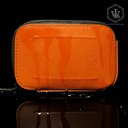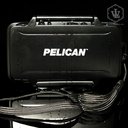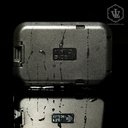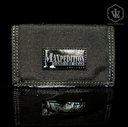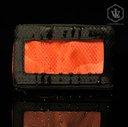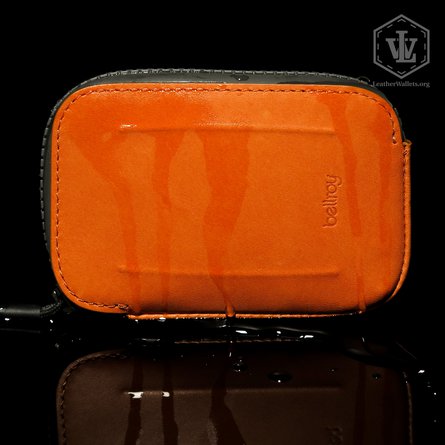Why Our #1 Pick is the Bellroy All Conditions Wallet
The Bellroy All Conditions Wallet is the best overall fit for the above criteria. It is very water-resistant (just don’t submerge it for more than a few seconds), can be used as both a water-resistant wallet and an everyday wallet, conveniently holds an ample number of cards and bills, and is made from durable top-grain leather with a couple of different color choices available. You can purchase RFID protection sleeves to fit in the Bellroy, and while more expensive than the other options, is still reasonably priced.
How We Ranked Each Wallet
We purchased and performed a number of tests on each wallet.
Unboxing. First, we reviewed them for packaging: gift boxes, protective bags, shipping boxes, country of origin.
Construction. We examined them for physical materials and construction. Were they well-made? Were they susceptible to wear in certain places? How did they smell and feel?
Capacity. We tested each pocket and card slot to see exactly how many standard credit cards and paper bills each wallet would comfortably hold.
Water-resistance. We performed three levels of water testing, depending on how well each wallet did at each stage. First, we sprayed the wallets with water. Then we briefly dropped them in water. Finally, we fully submerged the wallet in water. Moisture indicator stickers and tissue paper inside the wallet helped us verify whether each wallet had protected its contents at each stage of testing.
RFID protection. We tested each pocket of the wallets to see if a smartcard and a proximity card would scan through their lining. We tested them with separate radio frequency card readers that scan for 125 kHz (proximity cards) and 13.56 MHz (credit and other smart cards).
What to Consider when Deciding on a Waterproof Wallet
Besides the normal marks of quality and functionality that we’ll discuss at the end of this section, a waterproof or water-resistant wallet should have a couple of extra features: water-resistance and versatility.
Water-Resistance
The first question is whether you need your wallet to be completely waterproof or only water-resistant. Are you taking it with you in the water or do you simply want to ensure that it and the contents of your wallet are protected if it gets splashed or dripped on? Do you work in a wet environment but need to keep your wallet in your pocket? Do you want a wallet that won’t be damaged if it gets wet or one that will also keep the contents of your wallet dry?
There are different levels of water-resistance and different ways to market a product is waterproof. In general, look for an IP rating, but certifying can be costly, so a lot of wallet makers simply market their water-resistance without certifying. Our reviews will tell you exactly what you can expect from each model. The main thing is to realistically envision what you want your wallet to do.
If you want a wallet that won’t be damaged by water but will also allow everything else to get wet, you have a lot more options open to you. You can go for any coated leather, faux leather, plastic, or nylon wallet out there. If you’re looking for something that will keep your contents dry after a quick splash or dropping it in a puddle for a second, look for a wallet with a zipper or a tight-snap closure. If you need to take the wallet into the water with you, you’re going to need something with a waterproof gasket, not just a zipper. Even divers with zip-up wetsuits are still wet when they take off their gear.
Versatility
Do you want your waterproof / water-resistant wallet to also serve as your everyday wallet? You probably won’t want to carry a hard plastic shell around as your daily wallet unless you’re also a perpetual bag carrier. Hard plastic simply isn’t comfortable as a back or front-pocket option. It’s also not very flattering with a hard, rectangular bulge showing through your pants.
Choose a wallet made of coated leather or one of water-resistant nylon. You can find an option that will meet your water-resistance needs but also be comfortable, functional, and attractive enough to carry around town even when it’s not particularly wet out.
Materials
Here we’re looking at the quality of the materials used for the exterior of the wallet. We’ll consider stitching, lining, and other components in the next section. First, we’ll talk about leather wallets and then consider nylon and polycarbonate materials below.
Leather Quality
If you’re considering a water-resistant leather wallet, pay attention to the type of leather advertised. Full-grain is leather that has not been altered from its original pattern. It will make the most unique pieces of leather because it will show all of the marks from the animal’s hide. Were they branded? Did they have birthmarks? Did they injure themselves on a fence or roughhousing with a brother animal? You’ll see it on the piece of leather you receive. You’ll see the animal’s natural pores and even where they got bit by mosquitoes. Full-grain leather is for those who want the most authentic looking leather. It’s strong and durable, lasting more than a hundred years.
Top-grain leather is equally as durable but does not show the animal’s history. Some people call it corrected-grain leather. The tanner has sanded the leather down to remove any markings or surface texture. Sometimes, they will emboss the leather with an artificial texture. Otherwise, they’ll leave it smooth for a sleek finish.
Genuine leather, split leather, bonded leather, faux leather, vegan leather, and koskin all have very low durability. Genuine leather, split leather, and bonded leather is made from the under layers of an animal’s hide. It’s the tissue below the material used in full-grain and top-grain products. In some cases, it’s not even made from one piece but is scraps glued back together. Manufacturers make this low grade of leather look like full or top-grain by embossing and/or coating it with polyurethane. Faux, vegan, and koskin leather are also made to appear as leather with polyurethane coatings. In reality, they have no leather in them, just coated fabric.
If you see a product advertised as full or top-grain, you know that it will last a lifetime. If it’s any type of fake leather or low-quality leather, take a hard pass on it. It won’t last more than a couple of years. If the manufacturer doesn’t advertise what type of leather it is, assume it’s low quality.
Full-grain and top-grain leather will be more expensive than lower grades or faux leather products. There’s less of the top material to harvest from a hide, it takes more skill to tan it, and it’s in higher demand as a high-quality material. Genuine leather or bonded leather that uses the lower layers has an abundant supply. The polyurethane that is made to coat it and faux leather options is fast and easy to make in large quantities at low costs.
Leather Tanning
You’ll also want to note how the leather was tanned. If it’s a water-resistant wallet, it will be finished with a protective topcoat, but if that topcoat fails, you want to make sure your wallet is still as resilient as possible.
The two main types of tannins are vegetable and chromium. Vegetable-tanned leather is less water-resistant than chrome-tanned leather. The main difference is that if vegetable-tanned leather gets wet, it will discolor the material. Dark spots form that will not go away. Chrome-tanned leather is more water-resistant and shows less spotting when it is affected.
If you’re looking for a waterproof or water-resistant wallet, make sure it doesn’t have vegetable-tanned leather.
Vegetable-tanned leather also costs more than chrome-tanned because it takes longer to tan with plant-based materials.
Leather Thickness
If you can, feel the thickness of the leather on your water-resistant wallet. Manufacturers remove layers of hide to be able to work with it and shape it into foldable wallets, but it shouldn’t be so thin that it can’t support its own weight or keep its form. Thin leather will also wear through faster. Feel it to determine how thick the leather actually is. In thin wallets, the manufacturer will support the shape by adding plastic or cardboard inserts between the layers. You need a wallet that can stand up on its own without added materials. If you do find a wallet that’s extremely thin, it’s also most likely genuine or faux leather, not full or top-grain. You’ll see our video reviewer feel for inserts.
As you can guess, substantially thick leather costs more than thin because the manufacturer is using more layers of the hide to make the product. Otherwise, they could use the rest of the under layer to make genuine leather goods or sell it to another manufacturer who makes such products.
Leather Scent
Smell the leather. It should have a clean, mild odor to it. Avoid wallets that smell too much like plastic or chemicals. Even if the wallet is coated to provide water-resistance, you should still be able to smell the leather over the finish. Wallets that are overly processed show that they don’t have enough quality in the leather itself and therefore need to be reinforced with adhesives and coatings, or are simply made and shipped too quickly to exhibit the best practices in craftsmanship. If you were a company selling a high-quality good, would you send it to them still carrying such an awful aroma? For the wallet options we present, you’ll see Trevor smell each leather wallet we purchase.
Leather that smells like leather costs a little more because the manufacturer has been more careful in the finishing process and taken more time before shipping it out. They’re demonstrating that their product is not a rush job.
Leather Feel
Finally, feel the surface of the leather. Almost every leather wallet you can buy will have a smooth finish, but it shouldn’t feel like plastic. You should still feel some of the leather texture, even on a water-resistant model. After all, if you can’t feel the leather, what’s the point of spending for the leather? If it has too slippery of a finish, it might be good for water-resistance, but it isn’t good as a leather wallet. Slippery finishes are for low-grade leathers coated in vinyl or polyurethane.
Again, leather with an authentic feel costs more because it takes more ingenuity to finish a wallet well than it does to slap layer after layer of coatings on it.
Nylon
Nylon is a type of plastic that is very strong and flexible. If you’re looking for a water-resistant wallet, you can be sure that nylon will prove to be a durable material that will show very little wear with normal use. However, nylon is not a water-resistant material. In fact, nylon absorbs water, making it an ill-fit for wet applications.
Nylon can be made easily with cost-effective methods, helping to make nylon products less expensive.
Polycarbonate
Polycarbonate is another thermoplastic. It’s used for strength and impact-resistance. Polycarbonate wallets might not be the most comfortable, but they will prove to be durable options for normal use.
Polycarbonate is widely used in a variety of applications and can be easily formed. You should expect this to be a low-cost material.
Construction
We’ve looked at the exterior materials to judge a wallet’s quality. Now we need to look at how the wallet is held together and any supplemental materials it contains in its design.
Stitching
A leather or nylon water-resistant wallet lasts only as long as the stitching that holds it together. Look for nylon or polyester stitching for the highest-quality wallets. These materials won’t degrade, and they won’t loosen in water. You’ll also want to make sure that the wallet is double-stitched or has some type of reinforcing pattern around the edges. The stitches should also be melted together at the corners to eliminate the threat of fraying. It also provides a professional, attractive finish. Cotton stitching is a lower-cost alternative that isn’t quite as durable.
If a wallet manufacturer doesn’t tell you what type of stitching they used, bet that it’s cotton.
Lining
Check the lining of the wallet. Is it pigskin, suede, nylon, polyester, silk, or cotton cloth? Pigskin is the most durable, followed by suede, both types of leathers themselves. Nylon and polyester are perfectly strong, durable materials for a lining. Silk and cloth are liable to tear, especially if you have a card with a rough edge.
More important than the lining material, however, is how it is stitched. Does the stitching cross the lining or protrude from the side of the pockets. If so, cards will catch the stitches as you slide them in and out of their slots, allowing the lining to pull away from the pocket.
Zippers
An important part of a water-resistant wallet or any security-type wallet is the zipper. Check to make sure that the zipper seals completely at the end. It should also be a little difficult to zip and unzip it, showing the strength of the connections. You should have to give it a little tug to get it started and smooth, even pressure the whole way up or down.
Clips, Snaps, Hinges, and Hardware
Does the wallet have a money clip? Does it snap shut? Does it have a hinge? Does it have a ring in it for a chain? Inspect all of these aspects for strength and durability. How strong is the clip? Does it have magnets or is it spring-loaded? How many bills can it hold securely? How strong is its connection to the wallet lining?
Move each hinge side to side. Snap the wallet shut and see if there are any gaps when you lift up on the front. How difficult is it to open again? It should take a little force. If the wallet opens with a button, how secure is the lever?
If you have loose hardware, it will only get worse in time.
Plastic and Elastic
Many wallets feature plastic ID windows. They’re incredibly useful for flashing your ID or work badge on command, but they’re also a weak component to any wallet. Plastic will dent or crack over time. It’s also susceptible to tearing away from the stitching. To get more use out of your ID windows, buy a wallet that includes the plastic on the inside of the wallet, not as an exterior pocket.
Some wallets, and a couple of these water-resistant wallets in particular use a mesh pocket. It might have an elastic band at the top. Others use an elastic band to secure the wallet or cards and money on the outside of the wallet. Still others use elastic pull-tabs to access cards.
Keep in mind that elastic features might offer some neat design mechanics or functionality, but it will stretch out or tear faster than the rest of your wallet. If you’re using a leather wallet with a pull-tab, that pull-tab is going to be first to go, leaving you without the functionality that it was supposed to provide. If you need an elastic band to keep your wallet closed or some contents secure, it will stretch out or break, making your wallet next to useless.
Craftsmanship
Finally, after material quality and construction, inspect the wallet for craftsmanship. This includes cut quality, pocket edges, and corners. None of these are indicative of material quality but do show whether the manufacturer took shortcuts or did all they could to create a finely crafted wallet.
Cuts
All wallets, whether they be leather, nylon, or polycarbonate, should have even, parallel cuts. You don’t want to see wavy lines along an edge, pockets that aren’t parallel to one another, or gaps along the seam of a snap-shut wallet.
Pocket Edges
What does the top of the wallet’s card slots look like? Do they end in a straight cut or do they fold or roll over? A high-quality wallet will fold the material all the way down past where the top of the card will lie so that when removed the cards don’t catch on the lip. They could also roll the leather over on the front of the pocket, creating an attractive, stylized finish. In order to have a straight cut, the leather needs to be thick. In order to have a rolled edge the leather needs to be thin... So, you have a wallet like the Hanks Belts Money Clip wallet where it is thick enough throughout the wallet to handle a straight cut. On the other side of the spectrum is the Alpine Swiss where the leather is way too thin to have a straight cut, and so it is rolled over. Lastly, there exists a super-premium wallet where the leather is thick all the way to the edge where it is skived thin enough to roll over. This is typically done by hand and denotes a labor-intensive wallet to build.
Corners
When you look at the corners of the wallet or the transition from exterior to interior, does the wallet appear smooth and uniform or can you see the individual layers of fabric? A high-quality wallet will have blended edges and corners. The corners should also be rounded rather forming sharp, right angles. Wallet makers achieve this look by cutting the leather or fabric down at the corners and edges so that the layers will meet and blend to form a smooth surface. An alternative method would be to add a layer of bonding material to the edges, minimizing any unevenness. The downfall is that bonded edges are still too thick and the adhesive will peel away over time.
Warranty
It is difficult to judge a wallet’s quality by the warranty a company offers. We’ve seen high-quality wallet manufacturers offer no warranties or warranties that last 100 years. Of course, you always have a 30-day return policy, but do you need more than that?
It depends on the quality of wallet. Many manufacturers who sell low-quality wallets don’t offer a warranty or offer a very short warranty of 6 months or less, knowing that their products are not going to last longer than that and do not want to accept returns when they fail. High-quality wallet manufacturers might not offer a long warranty because they know their wallets are built to last and know that consumers won’t have a reason to return them or ask for repairs.
We’re most comfortable with high-quality wallets that come with a 1-3-year warranty. Even wallet makers who employ expert craftsman creating wallets out of high-grade materials can make mistakes. You should have the ability to return, exchange, or request repairs if you do find one of those mistakes. Most often, the problem will be unraveling stitching. Look for manufacturers who give you 1-3 years of using your wallet before they consider the sale final. It provides you enough time to discover mistakes while not making them beholden to you forever.
Size and Weight
Now we’re getting into functionality. The matter to consider here is how comfortable you want your wallet to be. Where do you want to carry it? Back pocket, front pocket, suit pocket, in your bag, around your neck or wrist?
You have options, especially with a water-resistant wallet. If you’re looking for a versatile wallet that you could use as your everyday wallet, smaller is probably better. A nice-sized front-pocket wallet is going to be approximately 3.5 inches tall by 4.5 inches wide. That will give you enough room to store your cash without having to triple fold it. It should also provide plenty of space for card slots in the interior of the wallet. Many wallets that we review are even smaller and provide the same functionality.
A wallet larger than 3.5” x 4.5” becomes unwieldy as a versatile wallet and will also start to weigh more, making your pockets sag. Look for a wallet that weight 40-75 grams when empty to ensure that it has an ample thickness of leather or other material without becoming too heavy when you fill it up.
Capacity
How many cards and bills do you need to carry? If you want to use your water-resistant wallet for everyday use, be realistic about how many bills and cards you really need at any one time. You can pare your wallet down by carrying less cash and using your cards more, or leaving membership and discount cards out of your wallet unless you know you’re going to use them that day. See our guide on How to Reduce the Contents of Your Wallet for more information.
Once you have your contents down to the bare essentials, you’ll want to look at the design options for carrying your contents. Do you want everything together in one center pocket? Do you want individual card slots that hold 2-3 cards each? How about outside pockets? Would you rather have a band holding your cash on the outside of the wallet, a money clip on the inside, or a center cash pocket?
A water-resistant wallet needs to keep everything on the inside for getting wet but could also feature outside storage options for everyday use. Keep in mind that some design options, such as bands and outside pockets are more susceptible to wear.
Features
Besides bands, ID windows, and quick-access outside pockets, are there any other special features that you need in your water-resistant wallet? Do you need it to hold coins, SIM cards, or keys? Do you want it to have a pull-tab for your less-used cards? Again, the goal is to think about how you’re going to use the wallet to find the best match for functionality and durability.
RFID Protection
Are you concerned about identity thieves scanning the information on your smart cards? Most scanners can read your information through your wallet’s material. Wallets that come with RFID protection include a special blocking material in the lining that stops illegal scans.
Not all RFID linings are the same though. There are two common types of RFID cards that operate on different radio frequencies. Credit cards, membership cards, and IDs that store digital information typically use a frequency of 13.56 MHz. Proximity Cards, or key access cards, operate on a lower frequency of 125 kHz.
If you want a wallet that can block all scans, make sure that RFID protection covers both frequencies. If you want the wallet to only protect sensitive information but still allow you to scan your key cards through your wallet, get one that only blocks the higher frequency or features pockets that shield one but not the other.
You can also purchase RFID card protector sleeves for your smartcards and use them with any wallet.
Design
How much style do you want your wallet to have? Do you want it to showcase the brand of wallet you bought or do you need it to have a more subtle design?
If you buy a high-quality wallet, you should probably opt for the simpler approach. Like a tattoo, your wallet will last longer than you might like the brand logo. The company might go out of style, or your tastes might change.
Purchase Options
Once you decide on a wallet’s materials, capacity, features, and design, it’s also important to determine if the color options appeal to you. Some wallets come in 1 color, others in 16. Be sure to choose a color that will wear well and that you’ll be happy with for the life of the wallet. Again, simple, classic colors are probably better as they can be used in any situation.
Packaging and Gift Boxes
If you’re buying an expensive wallet, look into how it will be shipped to you. There’s nothing worse than picking out a high-quality wallet only to have it arrive damaged from transit. You can return it, but who wants to go through the hassle? Do a little research and ensure that the company cares enough about their product and customers to ship you a wallet with ample protection.
When you’re looking for a gift, check if the wallet comes with a gift box, and what that gift box actually is. Some manufacturers who offer a gift box send the wallet in nothing more than a plain box or envelope. Others send their product in a sturdy box with an attractive design.
Price
Don’t hesitate to spend more on quality. A high-quality wallet will last you longer than you need it to. A cheaply made, cheaply priced alternative is a waste of money because you’ll just need to buy another one in a year or two.
At the same time, don’t judge quality on price or branding. A company might charge a higher price for style or design features while using the lowest quality materials. A well-known brand might charge more based on their reputation or popularity, not the quality or functionality of their product. If you can find a high-quality wallet that meets your needs at a lower cost, don’t worry about whether you’ve heard of the company or not. Let the product speak for itself.
If you’re looking for the absolute best, submersible, waterproof wallet, the Pelican Sport Wallet is what you need. If you don’t need to submerge your wallet but still want reasonable protection, the Bellroy All Conditions model is a strongly water-resistant wallet. It’s also a full-grain leather option that you could use as your everyday wallet, not just your beach alternative.
Conclusion
The Chums Surfshort and Maxpedition Gear Micro failed all water-resistance tests. Water won’t hurt the wallet themselves, but they won’t do hardly anything to keep your contents dry. The Flipside 4 has minimal water-resistance but is the only one of the options we reviewed to feature RFID/NFC protection.
If we were to choose, we would probably pick up the Bellroy All Conditions Wallet for everyday use and the less expensive Pelican for a watersports counterpart. It never hurts to have some water-resistance to your leather wallet, and for those times that you do need to keep your wallet with you in thoroughly wet conditions, the Pelican Sport Wallet will do the trick wonderfully.
